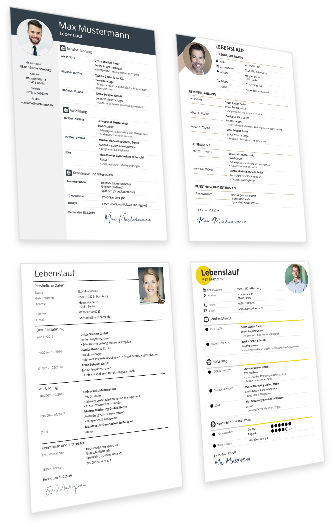
Resume Formats: Important Things to Keep in Mind
A strong resume needs a clear and well-structured layout, as recruiters want to be able to skim your application easily. By organizing your resume to highlight your most important qualifications, you help them to achieve a quick overview of you. Your resume should be structured to highlight your skills and background information. Try to look at it from an employer's perspective: which skills and qualifications would make you the right person for the job? This is exactly the kind of information that you should highlight in your resume. When coming up with a resume format, here's what should be included:
- The "personal details" section of your resume should contain key personal information about you, such as your name and address. This section of your resume can be kept rather short, however, as several federal laws all the way up to the Civil Rights Act of 1964 have made much of this personal information optional. For example, employers are not allowed to discriminate based on your ethnicity or religion. It’s usually safest to limit the information in this section to your name and any information the recruiter needs to contact you.
- The “resume profile” section should include a few sentences that summarize either your professional career or your motivation for getting into the field for which you’re applying. If you don’t have a lot of work experience, you should focus on your motivation. If you already have several years or experience in the field, a short summary helps recruiters to get a clear picture of you without reading through your entire “work experience” section.
- The “work experience” section should be a concise list of all your relevant work experience. For every entry, you should include your job title and the name of your employer, as well as a short description of your responsibilities and the work you carried out regularly while employed there. You can also mention internships in this section of your resume. Just ensure to not clutter the list—keep it informative and concise, mentioning the most important successes and milestones achieved on the job.
- The "education" section should list your educational qualifications, including your high school diploma or GED, college degrees or other qualifications. There is no need to list everything, though, if you already have work experience to show for. In this case, just highlight the most important degrees you have and put more emphasis on your “work experience” and “skills and abilities” sections instead.
- "Skills and abilities" should be the next section of your resume. This section includes any additional qualifications you have acquired independently or while working in a specialized job. IT skills and language skills are often listed in this section of the resume. Just remember, you want to give your future employer a good idea of how proficient you are with these skills. It's always useful to have a certificate that proves your near-native skills in a foreign language, for example.
- A final "hobbies" section is entirely optional, though it can be helpful for your prospective employer. Consider if any of your hobbies and personal interests may reflect positively on your qualifications for the job. Your hobbies can demonstrate desirable skills and character traits, such as a creative mind or the ability to work well as part of a team.
Life isn't just about school and work, so most job seekers will inevitably have gaps in their resumes. In the past, sufficiently large gaps in a resume would have been reason enough for recruiters to ignore your application. The situation is different today, though. As a rule of thumb, gaps of up to two months don't need to be explained and won't reflect negatively on you. However, if those gaps are longer, be sure to explain them in your cover letter or resume. And stick to the truth! It's quite possible that any inaccuracies in your job application could come to light during the interview process.
What Is the Correct Structure for Your Resume?
The order of the individual sections of your resume isn't set in stone, but it’s advisable to start with your personal details. This allows recruiters to identify applicants easily. When choosing the next section of your resume, you're free to emphasize whichever aspect of your background that would strengthen your application.
For example, you can list your achievements in education first if you don't have a lot of work experience yet, or you can list your work experience first if you've gathered valuable skills through years of employment. Generally speaking, you should place your work experience after your personal details and resume profile if you already have several years of experience working in a job. In either case, your educational and professional experience is followed by your "skills and abilities".
If your prospective employer prefers to use application forms to hire new employees, the resume format may not be as relevant, since it will likely be determined by the structure of the form. However, it's wise to keep in mind all the points we've discussed regarding which details you should emphasize in your application, even when completing a standardized application form.
Resume Design: Which Formatting Suits the Structure Best?
There are two preferred ways to structure your resume, so there’s no need to experiment with the design and structure:
- Listing all your work experience in one column is often the preferred method, as it gives you lots of space to describe your career stages with bullet points. Write down your job title, place of employment and the corresponding dates, followed by bullet points.
- Alternatively, you can use a two column format, with the left-hand column listing the dates, while the right-hand column lists the corresponding information about your employment situation at the time. This format has the advantage of making the dates stand out, and it creates more white spaces which make your resume easier to read.
Use formatting or colors to highlight key points only when necessary—and be consistent about what you highlight. This will make important information stand out without distracting the recruiter with constant shifts in format.
When selecting fonts and font sizes, always emphasize clarity over aesthetics. Recruiters prefer easy-to-read fonts such as Arial, Calibri, or Times New Roman with a font size of 11 or 12 pt. Use bold type and italics sparingly, if at all. Less is often more when crafting your resume for a recruiter. When applying for a position as a designer or a similar profession, you may be able to catch the recruiter's attention by using creative design ideas. However, readability should be the primary goal of your resume.
Thanks to professionally crafted resume templates, you won't have to worry about the resume format at all. These templates are designed to meet all the requirements of a modern job application. You can also try to create your own unique design using standard word processing apps. Just ensure you know how to create a polished and cohesive design using the software. Otherwise, the results may end up looking more amateurish than appealing.

Don't worry about the structure or design of your CV. Just fill in the template and get the job of your dreams!
TemplatesCan a Resume Be Two Pages Long?
Typically, your resume should be as short and concise as possible. For most job seekers, this means one page. If you have an extensive professional career and can demonstrate a wide range of knowledge, skills, and educational qualifications relevant to the job for which you're applying, you can spread that information out over two pages. You definitely shouldn't try to squeeze too much information into one page, but be sure not to overload your resume with too much information on two pages either. Be concise and focus on the information that's actually relevant to the job for which you're applying. That way, you may be able to fit all the relevant information onto one page after all. If you end up with two pages, be sure to have a resume profile that’s concise and captivating, so recruiters will take the time to actually read both pages.

